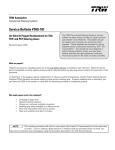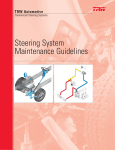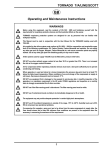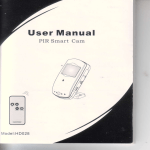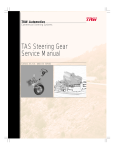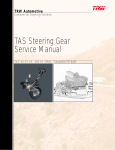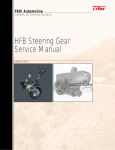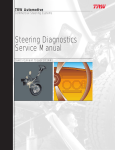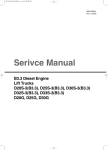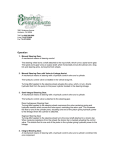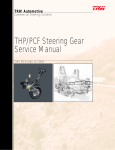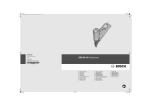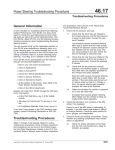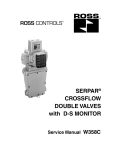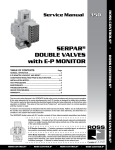Download installation instructions
Transcript
INSTALLATION INSTRUCTIONS REMANUFACTURED STEERING BOXES The installation procedures outlined in this booklet are intended to be used as a general guide. Always refer to manufacturer’s service manuals for complete instructions on mounting your steering gear for each application. Upon being rebuilt your steering gear has been adjusted to factory specifications. Red rubber coating has been put on these adjustment points and must not be tampered with. Blue rubber coating has been put on poppet adjustment points where applicable and poppet adjustment must be performed. Failure to perform poppet adjustments at blue coated points will affect warranty consideration. As recommended by all power steering manufacturers, a flow and pressure gauge should be used in troubleshooting and installation of power steering components. This will aid the installer in diagnosis of problems and aid in poppet adjustments, etc. Keep your system clean: We recommend that when a power steering gear or pump has been rebuilt or replaced: • All hoses and fittings are inspected • Fluid is flushed and replaced • All filters are changed Fluid The steering system must be kept filled to the specified levels at all times. Any mixture or unapproved oil could lead to seal deterioration and leaks. TRW/ROSS ATF Type “E’ or “F” Ford Spec. M2C138CJ Dexron II or III Mack EO-K2 Engine Oil Texaco SAE 10W40 Texaco SAE 15W40 SHEPPARD 10W40 Motor Oil Note: Series 5 & 6 Gears may be operated with ATF GM Power Steering Fluid, Hydraulic Fluid or Dexron Motor Oil is Preferred Note: M - Series gears may use 15W40, Dexron II or III Power Steering Fluid and ATF Type E & F Air Bleeding Single Steering Systems For steps 1 and 2, do not turn steering wheel. Otherwise air may be induced into the system. CAUTION 1. Fill the reservoir to nearly full. Crank the engine for 10 seconds without allowing it to start, if possible. If the engine does start, shut off immediately. Check and refill reservoir. Repeat at least 3 times, each time checking and refilling the reservoir. CAUTION Do not allow the fluid level to drop significantly or run out of the reservoir. This may induce air into the system. 2. Start the engine and let it idle for 2 minutes. Shut the engine off and check the fluid level in the reservoir. 3. Steer vehicle left and right several times but avoid steering full stop. Add fluid, as necessary, to full line on the dipstick. The above procedure should remove all air from the steering system; unless the gear is mounted in an invert position and is equipped with a manual bleed screw, commonly found in TRW/ROSS steering gears. If so, refer to step 4. 4. Follow steps 1, 2, and 3. Leave engine idling. With the steering gear in its center position, loosen the manual bleed screw about 1 turn, allowing the air and aerated fluid to “bleed out” around the bleed screw until only clear (non-aerated) fluid is bleeding out. Then close the bleed screw (5/16th inch socket required). Check and refill reservoir. Repeat procedure 3 or 4 times. Torque the manual bleed screw to 27-33lbs. CAUTION Do not move pitman arms by hand as this could introduce air into the system. Air Bleeding Dual Steering Box Systems With the steering gears installed, install the pitman arms to manufacturer’s specifications on appropriate timing mark. Ensure the arms will not interfere with any object when gears are stroked full travel. Fill reservoir, set park brake and fast idle engine. During bleeding process, check fluid in reservoir, add as required. With engine running and drag links disconnected, turn steering wheel left and right until slave gear strokes to full travel. Repeat 3 or 4 times. Install drag link on master box and repeat stroking slave a few more times. Turn steering wheel to align slave gear pitman arm to align with drag link and install. CAUTION Do not move pitman arms by hand as this could introduce air into the system. Air bleeding for an assist cylinder procedures are same as gears, only disconnect rod end and stroke unit in and out to full travel. Ensure rod will not interfere with any object. For RCS series slave gears, refer to manufacturer’s specifications or contact supplier. Poppet Adjustment HF, HFB, 292,392, 492, 592, M-Series The relief valve plunger adjustment is provided to automatically reduce the steering pressure when the road wheels have reached their limits of turn. This keeps the supply pump from operating at its maximum relief pressure when the road wheels are at their steering limits. System temperatures are therefore reduced and high stress loads on the mechanical components of the steering system are relieved. High pressure oil at either end of the piston will push the relief ball valve off its seat and fill the relief passage with oil at high pressure. At the opposite end of its passage the relief ball valve is held against the seat and holds the high pressure in the relief passage. As the piston moves close to limits of stroke, the adjustable relief plungers push the relief ball off its seat and the pressure is relieved. The distance the piston can move is dependant upon the total from axle/steering geometry and tire size. The relief valve plungers are adjustable to allow for variations or change in these areas. Adjustment Procedure: 1. Start engine and allow it to run at idle speed 2. Turn the steering wheel in one direction until a high pressure hiss is heard or the axle stops contact. 3. Turn the relief plunger in or out until the high pressure hiss is heard when ⅛th to 3/16th inch clearance between the axle stops. 4. Repeat this procedure for the opposite direction of steer and adjust the relief valve plunger on the opposite end of the steering gear. TRW TAS Series Gears All TAS series gears are equipped with a grease fitting by the sector shaft that must be greased using NLG 1 grade 2 chassis lube, using hand operated grease gun. Add grease until it begins to extrude past sector shaft dirt and water seal. It is recommended this be performed quarterly, more in severe applications. Your rebuilt unit has been pre-greased upon rebuilding. Failure to perform above procedures will affect warranty considerations. Service Bulletin #TAS-101 On-Vehicle Poppet Readjustments for TAS Gears What are poppets? Poppets are pressure unloading valves set to trip just before full turn is reached in each direction. When this procedure is completed correctly, system pressure will be reduced before the axle stop screw contacts the axle stop in both directions. To determine if the poppets require readjustment or if they are performing properly, install a Power Steering System Analyzer (PSSA) between the power steering pump and the steering gear. If poppet readjustment is necessary, you can leave the PSSA in the system to verify that the following procedure is completed properly. Why poppets might need to be readjusted: • • • • • • • After steering gear has been rebuilt Changing to larger tires Reduced vehicle wheel cut Pitman arm mistimed, condition corrected Steering gear being installed on a different truck Steer axle stop bolt(s) were bent or broken Steer axle U-bolt(s) were bent or broken Note: This resetting procedure will work in most cases with at least 1 ¾ hand wheel turns from each side of center. If you’re making a large reduction in wheel cut and this procedure does not work, you may have to internally reset the poppets using the procedure described in the TAS service manual. 1. Set the axle stops to vehicle manufacturer’s wheelcut or clearance specifications. Set axle stops, Warm-up system Start the engine and allow the vehicle to idle for 5-10 minutes to warm the hydraulic fluid. Shut off the engine. Assemble adjusting screw into nut 2. If a new poppet adjusting screw and nut are being used, turn the screw into the non-sealing end of the jam nut until the drive end of screw is flush with the nut. Your steering gear will have either a fixed stop bolt or an adjusting screw. If the adjusting screw is already part of the steering gear, back the nut off of the adjusting screw until it is flush with the end of the adjusting screw. 3. Make sure the engine is off and the road wheels are in straight ahead position. Remove and discard the poppet fixed stop bolt (if equipped) Remove poppet and washer (if equipped) from the stop bolt lower end of the housing. If the unit has a poppet adjusting screw and sealing nut that need to be replaced, remove and discard them. 4. Turn the adjusting screw and sealing nut assembly, without rotating the nut on the screw, into Turn adjusting the housing until the nut is firmly screw assembly against the housing using a 7⁄32” into housing Allen wrench. Tighten the sealing nut against the housing. CAUTION If the drive end of the screw is below the face of the nut, the poppet seat flange will break during step 7d. 5. Refill the system reservoir with approved hydraulic fluid. Refill reservoir CAUTION Do not mix fluid types. Mixing of transmission fluid, motor oil, or other hydraulic fluids will cause seals to deteriorate faster. Jack up vehicle 6. Place a jack under the center of the front axle and jack up the front end of the vehicle so the steer axle tires are off the ground. 7. a. Start the engine and let it run at idle speed. b. Note which output shaft timing Push upper poppet mark is nearest the housing out to prepare it for piston bore. setting c. Turn the steering wheel in the direction that makes this timing mark move toward the adjusting screw just installed. Turn in this direction until axle stop contact is made. d. Pull hard on the steering wheel (put up to 40 lb. rim pull on a 20” dia. steering wheel) after the axle stop is contacted. 8. Set upper poppet CAUTION a. Turn the steering wheel in the opposite direction (end of timing mark away from adjusting screw) until the other axle stop is contacted. b. Pull hard on the steering wheel (put up to 40 lb. rim pull on a 20” dia. steering wheel). c. Release the steering wheel and shut off the engine. Do not hold the steering wheel at full turn for more than 10 seconds at a time; the heat build-up at pump relief pressure may damage components. 9. Loosen the sealing nut and back out the adjusting screw until 1” is Back out adjusting past the nut. Tighten the sealing screw nut against the housing. WARNING The length of the adjusting screw beyond the nut must be no more than 1 1/16” for proper thread engagment NOTE The length of adjusting screw beyond the sealing nut may be different for each vehicle. 10. Set lower poppet 11. Position adjusting screw a. Start the engine and let it idle. b. Turn the steering wheel in the original direction (end of timing mark toward adjusting screw), until axle stop contact is made. c. Hold the steering wheel in this position (with up to 40 lb. rim pull) for 10 seconds, then release. Repeat this hold and release process as many times as necessary while completing step 11. a. With steering wheel held tightly at full turn loosen the jam nut and hold it in place with a wrench. b. Turn the adjusting screw in (clockwise) using fingerpressure only (don’t use a ratchet), until the Allen wrench stops. Do not attempt to turn it in further. Pause the turningin process each time the driver releases the steering wheel; continue turning only while the wheel is held at full turn. c. Back off the adjusting screw 3¼ turns and tighten the sealing nut. Torque sealing nut to 35 lbf•ft. 12.The poppets have now been completely reset. Lower the vehicle. Check the reservoir and fill if required.










